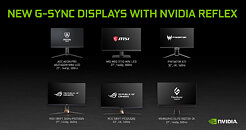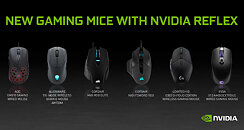TheLostSwede
News Editor
- Joined
- Nov 11, 2004
- Messages
- 18,072 (2.45/day)
- Location
- Sweden
| System Name | Overlord Mk MLI |
|---|---|
| Processor | AMD Ryzen 7 7800X3D |
| Motherboard | Gigabyte X670E Aorus Master |
| Cooling | Noctua NH-D15 SE with offsets |
| Memory | 32GB Team T-Create Expert DDR5 6000 MHz @ CL30-34-34-68 |
| Video Card(s) | Gainward GeForce RTX 4080 Phantom GS |
| Storage | 1TB Solidigm P44 Pro, 2 TB Corsair MP600 Pro, 2TB Kingston KC3000 |
| Display(s) | Acer XV272K LVbmiipruzx 4K@160Hz |
| Case | Fractal Design Torrent Compact |
| Audio Device(s) | Corsair Virtuoso SE |
| Power Supply | be quiet! Pure Power 12 M 850 W |
| Mouse | Logitech G502 Lightspeed |
| Keyboard | Corsair K70 Max |
| Software | Windows 10 Pro |
| Benchmark Scores | https://valid.x86.fr/yfsd9w |
In addition to the new game titles with Reflex support that Nvidia announced during its CES press conference, the company has also announced an additional eight displays and six mice that are now supported. Four of the displays are part of Nvidia's new 1440p esports display scheme and comes from AOC, MSI, ASUS and Viewsonic, one being the Alienware QD-OLED display, with the remaining three being 4K miniLED displays from Acer, Asus and HP. The 1440p esports monitors are all capable of a refresh rate of at least 300 Hz, with the ASUS ROG Swift going as high as 360 Hz.
We've already covered the Alienware QD-OLED display in a separate news post, so we'll skip it here. The 4K miniLED displays consist of the Acer Predator X32, the ASUS ROG Swift PG32UQXE and the HP Omen 32u, all 32-inch displays, with the Acer and ASUS displays being capable of 160 Hz refresh rates. We can't find any details about the HP display beyond the limited information provided by Nvidia.


As for the mice, we're looking at some new and some old models, all detailed in the picture above. There isn't really much to say here, as they should function like any other Reflex compatible mouse, although the Alienware and the Logitech are both wireless mice, which seems somewhat odd, since the wireless connection would introduce some additional lag, no matter what the manufacturer's claim.
In related news, Nvidia also announced that flagship OLED TV's from LG, Philips and Xiaomi will auto detect Nvidia GPUs and apply the correct settings required for low latency gaming. Nvidia's GeForce RTX 30, 20 and GTX 16 series GPUs will also be getting support for HDR10+ gaming this year, although Nvidia didn't provide a specific date as to when this would happen.
View at TechPowerUp Main Site
We've already covered the Alienware QD-OLED display in a separate news post, so we'll skip it here. The 4K miniLED displays consist of the Acer Predator X32, the ASUS ROG Swift PG32UQXE and the HP Omen 32u, all 32-inch displays, with the Acer and ASUS displays being capable of 160 Hz refresh rates. We can't find any details about the HP display beyond the limited information provided by Nvidia.


As for the mice, we're looking at some new and some old models, all detailed in the picture above. There isn't really much to say here, as they should function like any other Reflex compatible mouse, although the Alienware and the Logitech are both wireless mice, which seems somewhat odd, since the wireless connection would introduce some additional lag, no matter what the manufacturer's claim.
In related news, Nvidia also announced that flagship OLED TV's from LG, Philips and Xiaomi will auto detect Nvidia GPUs and apply the correct settings required for low latency gaming. Nvidia's GeForce RTX 30, 20 and GTX 16 series GPUs will also be getting support for HDR10+ gaming this year, although Nvidia didn't provide a specific date as to when this would happen.
View at TechPowerUp Main Site



